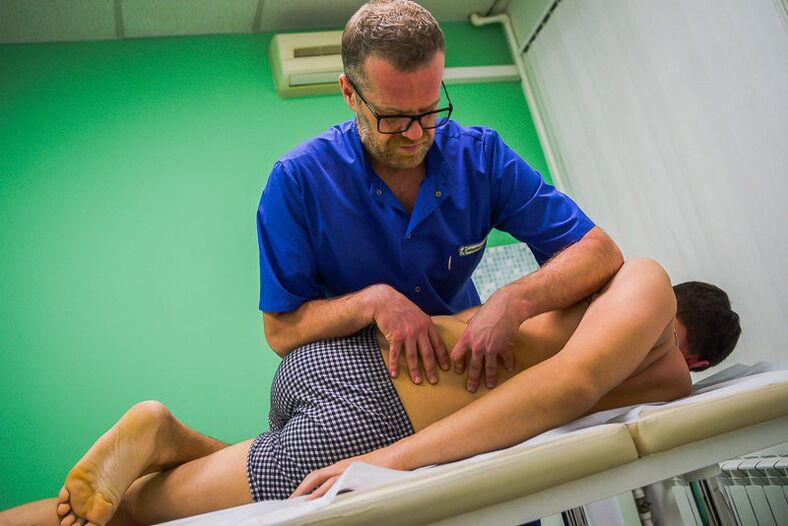
A modern person, having crossed the age limit to 25 years, periodically begins to experience pain in the lower back, the frequency and intensity of which varies. Over time, the incidence of unpleasant symptoms increases, pain sensations increase. The period of exacerbation continues more and more. This is a clinical picture of the development of lumbar osteochondrosis - a disease in which there is a gradual destruction of the cartilage tissue of the intervertebral discs. They become thinner, deformed, their protuberance sets in. In advanced cases, in the absence of suitable treatment, the low back pain becomes unbearable and interferes with usual movements. At this point, as a rule, a lumbar disc herniation is diagnosed.
It is a kind of retribution of a person for the upright posture and upright position of the body. When moving to an upright position, the center of gravity has shifted, which we have in the lumbar region. This means that the full weight of the body when walking, running, jumping, flexing the trunk and other movements puts pressure on the vertebrae of the lumbar spine. With an insufficiently developed muscular framework of the back and abdominal press, destruction of the intervertebral discs, the appearance of osteophytes and other pathological formations occurs. And these are common causes of back pain.
Other causes of back pain
In addition to osteochondrosis and its complications, there are other causes of low back pain. First of all, various injuries must be excluded, which could affect both the integrity of the cartilaginous mucosa and the vertebral body. These can be vertebral fractures, spinous process fractures, compression fractures of the spine with displacement of the structures of the spinal cord.
Lower back injuries can be caused by frontal and tangential impacts, falls from heights, and traffic accidents. Often times with injuries, athletes who are professionally involved in weightlifting sports request an appointment.
In women, low back pain can be caused by pelvic inflammatory disease. Among them is annexitis. In second place is cystic ovarian disease, which causes tight, aching lower back pain that is exacerbated at certain times of the menstrual cycle. After the age of 45, it is not uncommon for low back pain in women to be caused by tumor processes - uterine fibroids, oncological neoplasms of the ovaries and cervix.
In both sexes, there are such causes of low back pain as inguinal hernia and kidney disease: pyelonephritis, polycystic, amyloidosis, glomerulonephritis. To exclude renal pathology, it is necessary to consult a nephrologist and pass urine tests according to Nechiporenko, according to Zimnitsky. Helps to differentiate the diagnosis from renal ultrasound.
In some cases, the cause of pain in the upper lumbar region is intercostal neuralgia or shingles. The first condition can be distinguished by palpation of the intercostal spaces. Usually with intercostal neuralgia this causes a sharp increase in pain and is characterized by unilateral localization. With shingles, a rash that is visible as small blisters filled with a clear fluid.
More dangerous causes of back pain can be tuberculosis and sarcoma. These diseases leave little chance of recovery. Sometimes they are disguised at the initial stage as ankylosing spondylitis, in which there is also stiffness of movement and severe pain in the lower back in the morning. Then all the symptoms disappear.
Lower back pain: what to do?
If the lower back hurts - what to do in this case, which doctor to seek help from? You can make an appointment with a therapist who, after careful examination, will establish the initial diagnosis and order additional examinations. Mandatory: general urinalysis, general blood test, ultrasound of the kidneys and urinary tract, exclusion of tumor processes in the abdominal cavity. Then a consultation with a neurologist, a gynecologist (for women) and a phthisiatrist may be appointed. To clarify the localization of the destructive process in the spine, X-ray and tomographic examination methods can be used.
The prescription of treatment depends on the diagnosis. With osteochondrosis of the lumbar spine, full treatment is possible only with methods of manual therapy. At the initial stage, the pain is relieved with the help of traction traction, osteopathy and therapeutic massage. Next, doctors work to restore the structure of the cartilage. To improve regeneration processes, reflexology, acupuncture and the introduction of minimum doses of drugs into biologically active points of the human body can be used.
After the restoration of physiological mobility, the rehabilitation treatment complex should be continued. It includes physical therapy and massages. You should also listen to the recommendations of experts on the organization of food, work and rest, the organization of your work and where you sleep. In some cases, it may be necessary to temporarily use a splint to support the spine.























